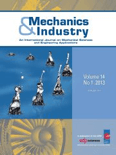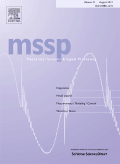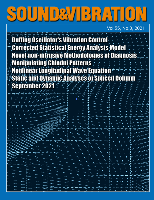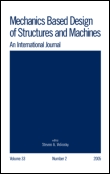
Journal of Vibration Engineering & Technologies
Scope & Guideline
Pioneering Research in Vibration Engineering
Introduction
Aims and Scopes
- Vibration Analysis and Modeling:
The journal covers methodologies for analyzing and modeling vibrations in mechanical systems, including complex structures and materials. This includes the use of advanced mathematical techniques and computational methods to predict vibration behavior under various conditions. - Control Systems for Vibration Mitigation:
Research on control strategies to mitigate vibrations in engineering systems is a core focus. This includes the development of active and passive vibration control systems, such as tuned mass dampers and magnetorheological dampers. - Energy Harvesting from Vibrations:
The journal explores innovative techniques for energy harvesting from vibrations, particularly in low-frequency applications. This includes piezoelectric systems and other mechanisms that convert vibrational energy into usable power. - Structural Health Monitoring and Fault Diagnosis:
A significant area of research involves the development of methodologies for monitoring the health of structures and diagnosing faults in mechanical systems using vibration signatures and advanced signal processing techniques. - Application of Advanced Materials in Vibration Engineering:
The journal emphasizes the use of advanced materials, including functionally graded materials and composites, in vibration applications, examining how these materials can enhance performance and reduce vibrations.
Trending and Emerging
- Machine Learning and AI in Vibration Analysis:
There is a significant trend towards integrating machine learning and artificial intelligence in vibration analysis and fault diagnosis. These technologies are being used to enhance predictive maintenance and improve the accuracy of diagnostics. - Nonlinear Dynamics and Chaotic Behavior:
Research exploring nonlinear dynamics and chaotic behavior in mechanical systems is gaining traction, particularly in understanding complex interactions in multi-degree-of-freedom systems and their implications for stability and control. - Smart Materials and Adaptive Systems:
The use of smart materials, such as piezoelectric and magnetorheological materials, in vibration control applications is on the rise. These materials enable dynamic response adjustments and enhance the performance of vibration isolation systems. - Sustainability and Energy Efficiency:
There is an increasing focus on sustainability and energy efficiency in vibration engineering, with research aimed at developing eco-friendly materials and energy harvesting systems that reduce reliance on traditional energy sources. - Advanced Computational Methods:
Emerging computational techniques, including finite element analysis and numerical simulations, are becoming more prevalent in vibration research, allowing for more accurate modeling of complex systems and interactions.
Declining or Waning
- Traditional Mechanical Systems Analysis:
There has been a noticeable decline in research focused solely on traditional mechanical systems without incorporating advanced materials or new technologies. The field is shifting towards more innovative approaches that integrate modern engineering practices. - Static Vibration Analysis:
Research centered on static vibration analysis has decreased, as there is a growing emphasis on dynamic analysis that considers time-dependent behavior and real-world applications of systems under various operational conditions. - Basic Fault Diagnosis Techniques:
While fault diagnosis remains a critical area, simpler, classical methods are increasingly being overshadowed by advanced machine learning and AI-based approaches that offer more robust and accurate diagnostics.
Similar Journals

JOURNAL OF VIBRATION AND ACOUSTICS-TRANSACTIONS OF THE ASME
Bridging Theory and Practice in Vibration StudiesThe JOURNAL OF VIBRATION AND ACOUSTICS-TRANSACTIONS OF THE ASME is a leading publication in the field of vibration and acoustics, committed to advancing knowledge and understanding in these vital areas of mechanical engineering. Published by the esteemed American Society of Mechanical Engineers (ASME), this journal has a strong presence in both the academic and professional communities, evidenced by its impressive Scopus rankings, which place it in the top quartiles of Acoustics and Ultrasonics (Q1), Mechanical Engineering (Q2), and Mechanics of Materials (Q2) as of 2023. The journal features original research articles, technical papers, and case studies that offer breakthrough insights and innovative methodologies, fostering a rich dialogue among scholars, researchers, and industry professionals. With its convergence of knowledge spanning from 1983 to 2024, it remains a crucial resource for those looking to stay at the forefront of research in vibration and acoustics. Although not currently open access, its rigorous peer-review process ensures high-quality content that is essential for practitioners and researchers alike.

Mechanics & Industry
Driving Progress in Manufacturing and Materials ScienceMechanics & Industry, published by EDP SCIENCES S A, is a prominent open access journal dedicated to the fields of Industrial and Manufacturing Engineering, Materials Science, and Mechanical Engineering. Since its establishment in 2004, the journal has served as a crucial platform for disseminating innovative research and developments in mechanics, catering to a diverse audience of researchers, professionals, and students worldwide. With an ISSN of 2257-7777 and an E-ISSN of 2257-7750, the journal is indexed in Scopus and has achieved a respectable Q3 quartile ranking across its categories for 2023. Mechanics & Industry emphasizes the importance of collaborative research and the sharing of knowledge, underpinning advancements in technology and industry practices. The journal's commitment to open access ensures that research findings are available to all, promoting sustainability and innovation within the global engineering community. Located in Les Ulis, France, this journal continues to uphold high standards of scholarly excellence and relevance in an ever-evolving industrial landscape.

Mechanika
Fostering Accessibility in Groundbreaking ResearchMechanika is a prominent open-access journal published by Kaunas University of Technology in Lithuania, with an ISSN of 1392-1207 and E-ISSN 2029-6983. Since its transition to open access in 2007, the journal has successfully facilitated the dissemination of vital research findings within the field of condensed matter physics, carving a niche for itself in a competitive academic landscape. Despite currently being categorized in the Q4 quartile for its impact in this area, Mechanika aims to foster advancements by providing a platform for innovative studies, reviews, and applications. As researchers, professionals, and students engage with its content, they will find an array of studies that push the boundaries of understanding in mechanics and related disciplines. Situated in the vibrant academic milieu of Kaunas, Mechanika is committed to quality, accessibility, and fostering scientific dialogue among the global academic community.

Romanian Journal of Acoustics and Vibration
Shaping the future of sound and vibration through rigorous research.Welcome to the Romanian Journal of Acoustics and Vibration, a pivotal publication produced by the Romanian Society of Acoustics, dedicated to advancing knowledge in the realms of acoustics and vibration research. With an ISSN of 1584-7284, this journal has been a vital resource for researchers, professionals, and students alike since its inception in 2012 and will continue to publish insightful contributions until 2024. The journal's rigorous selection process and scholarly articles ensure a high standard of research, contributing significantly to the Q3 and Q4 rankings in acoustics and ultrasonics as well as mechanics of materials, respectively. Although currently not an open-access journal, it provides invaluable insights into the latest developments and techniques within the fields of acoustics and vibration. Join a vibrant community that fosters innovation and scholarly dialogue, helping to shape the future of these crucial scientific disciplines.

PROCEEDINGS OF THE INSTITUTION OF MECHANICAL ENGINEERS PART C-JOURNAL OF MECHANICAL ENGINEERING SCIENCE
Fostering collaboration and innovation in engineering disciplines.PROCEEDINGS OF THE INSTITUTION OF MECHANICAL ENGINEERS PART C - JOURNAL OF MECHANICAL ENGINEERING SCIENCE, published by SAGE Publications Ltd, stands as a pivotal resource in the field of mechanical engineering, encompassing a wide array of topics from advanced materials to fluid dynamics and system design. With an impact factor reflective of its esteemed reputation, as indicated by its Q2 ranking in the Mechanical Engineering category, this journal serves as a vital forum for researchers, practitioners, and students alike. The journal boasts a rich history, converging research from 1983 to 2024, showcasing innovations and advancements that shape the mechanical engineering landscape. Although it is not an open-access publication, the insights and studies published herein provide invaluable contributions to the engineering community, fostering knowledge exchange and collaborative advancements. Researchers seeking a platform for their pioneering work will find Part C an ideal venue to disseminate their findings and engage with peers in this dynamic field.

MECHANICAL SYSTEMS AND SIGNAL PROCESSING
Innovating solutions at the intersection of systems and signals.MECHANICAL SYSTEMS AND SIGNAL PROCESSING, published by Academic Press Ltd - Elsevier Science Ltd, is a leading journal that bridges multiple critical fields, including Aerospace Engineering, Civil and Structural Engineering, Computer Science Applications, Control and Systems Engineering, Mechanical Engineering, and Signal Processing. Established in 1987, this esteemed journal serves as an invaluable resource for researchers, professionals, and students seeking to advance the understanding of mechanical systems and their intimate relationship with signal processing techniques. With an impressive impact factor and consistently ranked in the Q1 category across various engineering and computer science disciplines, it offers rigorous peer-reviewed articles that contribute significantly to innovation and methodological advancements in the field. Although it does not currently offer Open Access options, its publication in the United States ensures a wide dissemination of high-quality research that shapes the future of engineering. The journal's convergence until 2025 promises to foster enduring discussions and collaborations that will continue to push the boundaries of technology and engineering applications.

SOUND AND VIBRATION
Exploring the Dynamics of Sound and VibrationSOUND AND VIBRATION, published by TECH SCIENCE PRESS, is a pivotal journal in the fields of Acoustics and Ultrasonics, Mechanical Engineering, and Safety, Risk, Reliability, and Quality. With an ISSN of 1541-0161, this journal has been a reliable source of innovative research and developments from its inception in 1976 through to 2024. Although it currently ranks in the Q4 category on Scopus, it serves as a vital platform for the dissemination of studies focusing on sound and vibration phenomena, contributing to the understanding and advancement of engineering principles. Researchers and professionals are encouraged to utilize this journal to gain insights into critical acoustic applications and mechanical dynamics. While SOUND AND VIBRATION does not operate under an Open Access model, it remains a valuable asset for anyone committed to exploring the various ramifications of sound and vibration in engineering and applied sciences.

MECHANICS BASED DESIGN OF STRUCTURES AND MACHINES
Connecting Ideas, Enhancing ApplicationsMECHANICS BASED DESIGN OF STRUCTURES AND MACHINES is a premier academic journal published by Taylor & Francis Inc, dedicated to advancing knowledge in the fields of mechanical engineering, aerospace engineering, and more. With an impressive Q1 ranking in multiple engineering and physics categories for 2023, the journal is recognized for its high impact and critical contributions to research, as evidenced by its Scopus rankings that position it in the top percentiles across various disciplines. The journal focuses on innovative methodologies and applications pertaining to mechanics-based design, making it an essential resource for researchers, professionals, and students looking to enhance their understanding and application of design principles in structures and machines. As an open access publication, it ensures widespread dissemination of knowledge and facilitates collaboration across the global research community. For those interested in the latest developments and scholarly discussions, MECHANICS BASED DESIGN OF STRUCTURES AND MACHINES offers a vital platform that nurtures interdisciplinary dialogue and practical applications.

JOURNAL OF SOUND AND VIBRATION
Unveiling the science behind sound and mechanical dynamics.The JOURNAL OF SOUND AND VIBRATION, published by Academic Press Ltd - Elsevier Science Ltd, stands as a pivotal platform in the fields of Acoustics and Ultrasonics, Mechanical Engineering, and Mechanics of Materials. Since its inception in 1964, the journal has served as a beacon for researchers and practitioners looking to share and advance their knowledge on sound and vibration phenomena. With an impressive Q1 ranking in multiple categories and a Scopus ranking placing it in the top 10% of significant journals in related fields, it offers a high-impact venue for disseminating innovative research. The journal's well-rounded scope intersects fundamental and applied science, ensuring it remains relevant to a diverse audience, including students and professionals aiming to deepen their understanding of dynamic mechanical systems. Although primarily subscription-based, the journal's commitment to academic excellence makes it a valuable resource for all involved in the study and application of sound and vibration research, contributing significantly to advancements across engineering and physics disciplines.

SHOCK AND VIBRATION
Innovating solutions for engineering challenges.SHOCK AND VIBRATION, published by HINDAWI LTD, is an esteemed open-access journal that has been disseminating vital research in the fields of Civil and Structural Engineering, Condensed Matter Physics, Geotechnical Engineering and Engineering Geology, Mechanical Engineering, and Mechanics of Materials since its inception in 1993. Based in Egypt, this journal has earned its place within the Q3 quartile rankings across multiple engineering and science categories, showcasing its growing influence and commitment to advancing knowledge in these domains. Accessible to a global audience, it allows researchers, professionals, and students to share findings and foster innovation without paywalls. The journal proudly contributes to a deeper understanding of shock and vibration phenomena, addressing both theoretical and practical applications essential for various engineering disciplines. As a vital resource for academics and industry professionals alike, SHOCK AND VIBRATION serves as a cornerstone for the ongoing exploration and development of cutting-edge solutions in the engineering landscape.